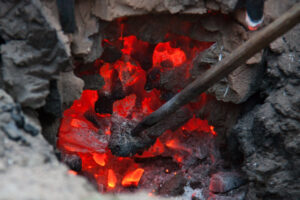Table of Contents
Introduction
We all realize that Extraction of Metals occur primarily in the form of salts that combine with other minerals to form ore. Such impurities should be removed using various inorganic separation techniques. Each step brings us closer to a purer metal content in the ore.
The primary goal of designing an extraction process is to minimize costs while obtaining the purest form of the metal possible. The easier the process, the better and less expensive it is for industries to extract metals from ores. This all depends on the metallurgical principles we use to examine the inorganic chemical properties of an ore’s constituents.
That’s how an extraction procedure is laid out. Each constituent is examined, and the best method for separating it from the others is chosen.
A Basic extraction of metals from ores:
Steps for extraction of metals listed below.
(1) Grinding and Crushing: In ball mills and crushers, larger chunks of ore are crushed and ground. It aids in increasing the surface area of the chunks for later chemical action. In technical language, this is referred to as pulverization.
(2) Concentrating Ore: One such step concentrates the ore by filtering out impurities. This is also known as ore dressing. Such a procedure is quite complex, and it is named after the equipment or technique that is used. It involves:
- Hydrolytic Method: The ground ore granules are poured over a vibrating table with a slope or inclination using the hydrolytic method. It is commonly used when the metal ore is significantly heavier than the impurities.
- Magnetic Separation: After pulverizing the ore, this technique is used to separate the ferromagnetic metal ore from the impurities.
- Froth Floatation: This seems to be one method of extracting metals from ores by combining two mediums. Impurities are separated using both oil and water.
- Chemical Separation: Chemical separation is indeed a method of concentrating the ore. For instance, the extraction of aluminium (Al) from bauxite ore.

(3) Calcination and roasting: After the ore has been concentrated using the methods described above, it is either heated in the presence or absence of air. Sulphide ores, for example, are heated in the presence of oxygen. It’s referred to as roasting. Carbonated metal ores, on the other hand, are heated in a vacuum to facilitate metal extraction. It is referred to as calcination. That’s how a concentrated ore is refined again to obtain purer metals.
Also read: Hydrogen As A Fuel
FAQs:
What is the process of extraction?
A solute is converted from one phase to another during the extraction process to separate it from unreacted starting materials or impurities.
How is the metal extracted from its ore?
Smelting or electrolysis are really the two main methods for extracting metal from crushed ore.
Which gas is used in the extraction of metal?
Carbon, as in form of coke or coal, is the most common reducing agent used in metallurgical processes. The hydrogen gas that is being used by the sponge iron-making industry, derives it from natural gas.



